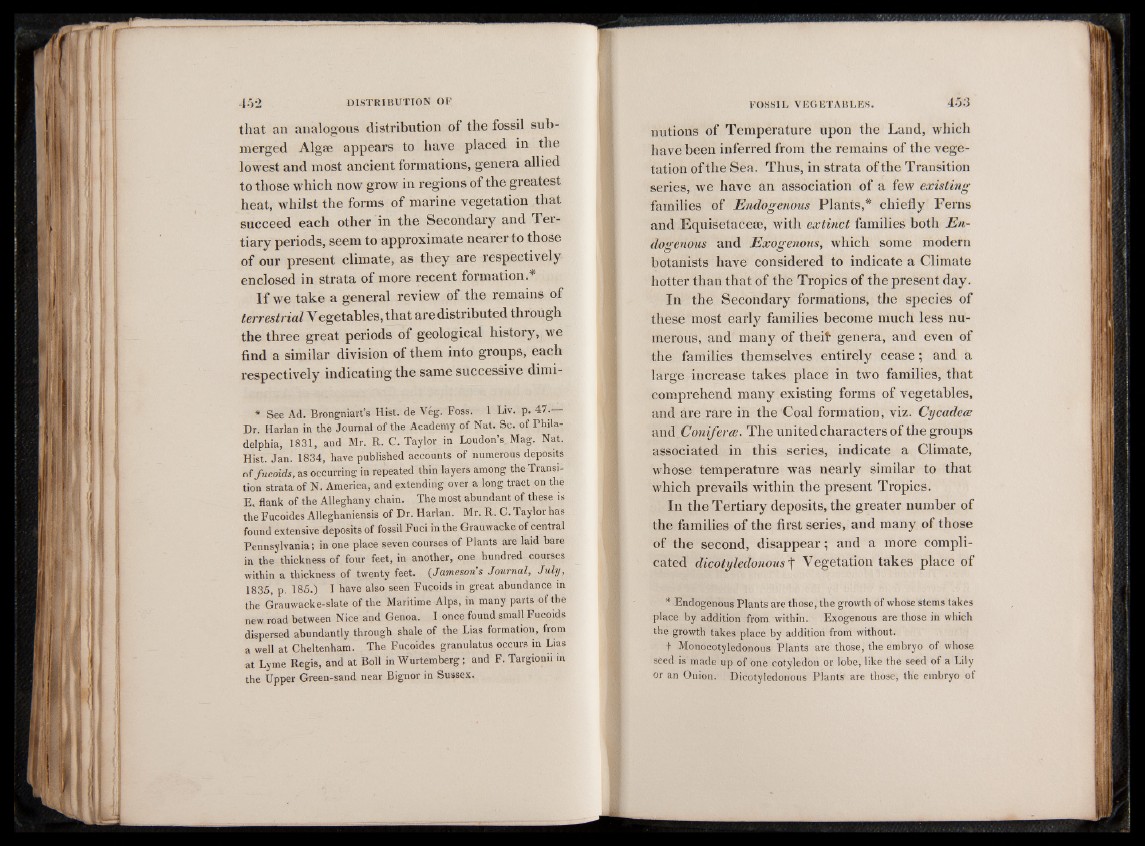
that an analogous distribution of the fossil submerged
Algse appears to have placed in the
lowest and most ancient formations, genera allied
to those which now grow in regions of the greatest
heat, whilst the forms of marine vegetation that
succeed each other in the Secondary and Tertiary
periods, seem to approximate nearer to those
of our present climate, as they are respectively
enclosed in strata of more recent formation*
I f we take a general review of the remains of
terrestrial Vegetables, that are distributed through
the three great periods of geological history, we
find a similar division of them into groups, each
respectively indicating the same successive dimi*
See Ad. Brongniart’s Hist, de Veg. Foss. 1 Liv. p. 47.—
Dr. Harlan in the Journal of the Academy of Nat. Sc. of Philadelphia,
1831, and Mr. R. C. Taylor in Loudon’s Mag. Nat.
Hist. Jan. 1834, have published accounts of numerous deposits
of fucoids, as occurring in repeated thin layers among the-Transi-
tion strata of N. America, and extending over a long tract on the
E, flank of the Alleghany chain. The most abundant of these is
the Fucoides Alleghaniensis of Dr. Harlan. Mr. R. C. Taylor has
found extensive deposits of fossil Fuci in the Grauwacke of central
Pennsylvania; in one place seven courses of Plants are laid bare
in the thickness of four feet, in another, one hundred courses
within a thickness of twenty feet. (Jameson's Journal, July,
1835, p. 185.) I have also seen Fucoids in great abundance in
the Grauwacke-slate of the Maritime Alps, in many parts of the
new road between Nice and Genoa. I once found small Fucoids
dispersed abundantly through shale of the Lias formation, from
a well at Cheltenham. The Fucoides granulatus occurs in Lias
at Lyme Regis, and at Boll in Wurtemberg; and F. Targionn in
the Upper Green-sand near Bignor in Sussex.
nutions of Temperature upon the Land, which
have been inferred from the remains of the vegetation
of the Sea. Thus, in strata of the Transition
series, we have an association of a few existing
families of Endogenous Plants,* chiefly Ferns
and Equisetacese, with extinct families both E n dogenous
and Exogenous, which some modern
botanists have considered to indicate a Climate
hotter than that of the Tropics of the present day.
In the Secondary formations, the species of
these most early families become much less numerous,
and many of theif- genera, and even of
the families themselves entirely cease; and a
large increase takes place in two families, that
comprehend many existing forms of vegetables,
and are rare in the Coal formation, viz. Cycadece
and Conifers. The united characters of the groups
associated in this series, indicate a Climate,
whose temperature was nearly similar to that
which prevails within the present Tropics.
In the Tertiary deposits, the greater number of
the families of the first series, and many of those
of the second, disappear; and a more complicated
dicotyledonous t Vegetation takes place of
* Endogenous Plants are those, the growth of whose stems takes
place by addition from within. Exogenous are those in which
the growth takes place by addition from without.
t Monocotyledonous Plants are those, the embryo of whose
seed is made up of one cotyledon or lobe, like the seed of a Lily
or an Onion. Dicotyledonous Plants are those, the embryo of